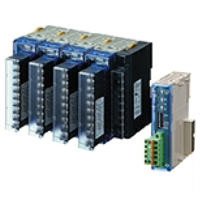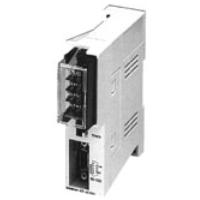(!)NOTE : Windows 7 users won’t be able to use some latest features of eCatalog/WOS since Microsoft is ending support for Windows 7 on 14 Jan, 2020. Please upgrade your system for uninterrupted services.
- Notice of End of Sales for Economy Series Pneumatic Equipment Category. More information.
PLC (Communication Units)(Connection Terminal:Terminal block/connector)
Brand |
|
|---|---|
| CAD |
|
| Days to Ship |
|
3 items
- Sort By
-
You can add up to 6 items per a category to the compare list.

EJ1 Module Type Temperature Controller
OMRON
EJ1 Module Type Temperature Controller
Communication Interface (Transmission Standard) Number of Ports Connection Terminal Representative Standard RS-422/485 - Terminal block/connector - From: ₹ 8,366.56 Days to Ship: 6 Day(s) or more  6 Day(s) or more
6 Day(s) or more
-
You can add up to 6 items per a category to the compare list.

RS-232C/RS-422A Conversion Unit NT-AL001
OMRON
Insulation type conversion unit.
[Features]
・ Convert RS-232C to RS-422 A/RS-485
・ RS-232C/RS-422 A conversion unit for connecting devices with RS-232C terminals such as PT and devices with RS-422 A terminals
・ Long-distance data transmission using RS-422 A interface is possible
・ Long-distance data transmission up to 500 m is possible
・ No power supply required
・ Duct wiring is possibleCommunication Interface (Transmission Standard) Number of Ports Connection Terminal Representative Standard RS-232 / RS-422/485 1 Terminal block/connector - From: ₹ 18,310.73 Days to Ship: 5 Day(s) or more  5 Day(s) or more
5 Day(s) or more
-
You can add up to 6 items per a category to the compare list.

FC6A Type All-in-One Programmable Controller MICROSMART Communication Module
IDEC
The FC6A type is the ideal PLC for the IoT era.
Communication Interface (Transmission Standard) Number of Ports Connection Terminal Representative Standard RS-232 / RS-422/485 - Terminal block/connector - From: ₹ 19,868.45 Days to Ship: 7 Day(s) or more  7 Day(s) or more
7 Day(s) or more
| Brand |
|---|
| Product Series |
| From |
| Days to Ship |
| Communication Interface (Transmission Standard) |
| Number of Ports |
| Connection Terminal |
| Representative Standard |
You can add up to 6 items per a category to the compare list. | You can add up to 6 items per a category to the compare list. | You can add up to 6 items per a category to the compare list. | |
| Brand | OMRON | OMRON | IDEC |
| Product Series | FC6A Type All-in-One Programmable Controller MICROSMART Communication Module | ||
| From | ₹ 8,366.56 | ₹ 18,310.73 | ₹ 19,868.45 |
| Days to Ship | 6 Day(s) or more | 5 Day(s) or more | 7 Day(s) or more |
| Communication Interface (Transmission Standard) | RS-422/485 | RS-232 / RS-422/485 | RS-232 / RS-422/485 |
| Number of Ports | - | 1 | - |
| Connection Terminal | Terminal block/connector | Terminal block/connector | Terminal block/connector |
| Representative Standard | - | - | - |
Loading...
Related Categories to PLC (Communication Units)
-
- PLC (CPU Units)
- PLC (Power Supply Units)
- PLC (Base Units)
- PLC (Software, Manuals)
- PLC Compatible Cables
- PLC Compatible Batteries
- PLC (Options, Others)
- PLC (Communication Units)
- PLC (Input/Output Units)
- PLC (Analog Units)
- PLC (Memory Units)
- PLC (Motion Controllers)
- PLC (Control Units)
- PLC (Wire-Saving Dedicated Units)
-
FAQ PLC (Communication Units)
- Question: What is a PLC Communication Interface and how does it facilitate data transfer in industrial environments?
- Answer: A PLC Communication Interface is a crucial component that enables data exchange between Programmable Logic Controllers (PLCs) and other devices in industrial settings. It acts as a bridge, allowing PLCs to communicate with sensors, actuators, and other controllers, fostering seamless information flow for precise control and monitoring of automated processes.
- Question: How can two PLCs communicate with each other, and what hardware is typically required?
- Answer: Two PLCs can communicate using various methods, including serial communication (RS-232, RS-485) or Ethernet. Hardware requirements often include communication modules or units compatible with the chosen communication protocol. These modules establish a reliable link, allowing PLCs to exchange data for coordinated operation.
- Question: What are the benefits of using an Ethernet-based communication unit for PLCs?
- Answer: Ethernet-based communication units offer high-speed and reliable data transfer, making them ideal for industrial applications. They support larger data volumes, facilitate communication with multiple devices simultaneously, and provide a robust foundation for the integration of industrial systems.
- Question: Can you explain the role of a communication processing unit within a PLC system?
- Answer: A communication processing unit in a PLC system manages the sending and receiving of data between the PLC and external devices. It interprets communication protocols, ensures data integrity, and plays a pivotal role in coordinating information flow for optimal control and monitoring of industrial processes.
- Question: What are the different types of communication units available for PLCs, and how do they compare?
- Answer: Common communication units include RS-232, RS-485, and Ethernet modules. RS-232 is suitable for short-distance communication, RS-485 allows for longer distances and multiple devices, while Ethernet provides high-speed, long-range communication with robust data handling capabilities.
- Question: How does Mitsubishi's PLC communication unit integrate with existing systems, and what are its key features?
- Answer: Mitsubishi's PLC communication unit seamlessly integrates with existing systems through its compatibility with various communication protocols. Key features include reliable data exchange, high-speed communication, and user-friendly configuration options, making it an efficient choice for diverse industrial applications.










How can we improve?
How can we improve?
Thank you for your time.
Your feedback is essential for our continuous improvement
Privacy Policy
Thank you for your cooperation.
Thank you for your time.
Your feedback is essential for our continuous improvement
Please use the inquiry form.
Privacy Policy